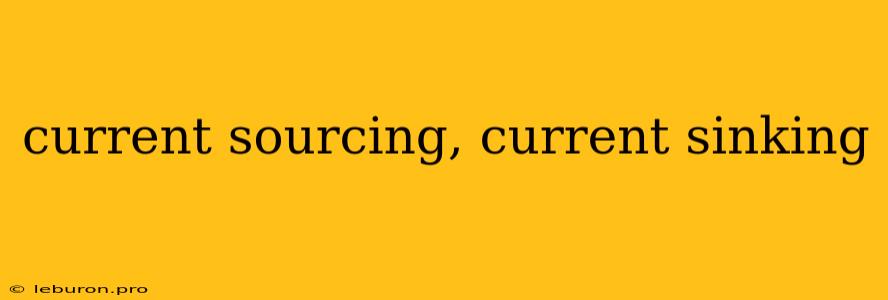Understanding Current Sourcing and Current Sinking: A Comprehensive Guide
In the realm of electronics, the flow of electrical current is fundamental. This flow, which constitutes the movement of electrons through a circuit, can be directed in two distinct ways: current sourcing and current sinking. These concepts are crucial for understanding how various electronic components interact within a circuit and how they manage power flow.
Current sourcing and current sinking are concepts often used in the context of electronic circuits, particularly when dealing with transistors, microcontrollers, and other active components. They describe the way in which a device handles the flow of current.
What is Current Sourcing?
Current sourcing describes a component that actively pushes or supplies current into a circuit. Imagine a device acting like a pump, actively pushing electrons into a load. This means the device is positive with respect to the load.
To understand current sourcing, consider these points:
- Direction of Current: Current flows out of the sourcing device and into the load.
- Voltage: The sourcing device's voltage is higher than the load's voltage.
- Output: The sourcing device outputs current.
A common example of current sourcing is a transistor used as a switch in a circuit. When the transistor is "on," it allows current to flow from the source (positive voltage) through the transistor and into the load.
What is Current Sinking?
Current sinking is the opposite of current sourcing. Instead of pushing current into a circuit, a current sinking device draws or absorbs current from the circuit. This means the device acts like a drain, pulling electrons away from a load. This means the device is negative with respect to the load.
Key points to remember about current sinking:
- Direction of Current: Current flows into the sinking device and out of the load.
- Voltage: The sinking device's voltage is lower than the load's voltage.
- Input: The sinking device inputs current.
A practical example of current sinking is a microcontroller pin configured as an output. When the pin is "high," it acts as a current sink, drawing current from the load and pulling its voltage low.
Key Differences between Current Sourcing and Current Sinking
| Feature | Current Sourcing | Current Sinking |
|---|---|---|
| Current Direction | Out of the device, into the load | Into the device, out of the load |
| Voltage | Higher than the load | Lower than the load |
| Role | Pushes current into the circuit | Draws current from the circuit |
| Output/Input | Outputs current | Inputs current |
Applications of Current Sourcing and Current Sinking
These concepts are fundamental in many electronic applications, including:
Transistors:
- Bipolar Junction Transistors (BJTs): Used for amplifying signals, switching circuits, and current gain.
- Field-Effect Transistors (FETs): Employed in a wide range of applications, including amplifiers, switches, and voltage regulators.
Microcontrollers:
- Input/Output (I/O) Pins: Microcontroller pins can be configured to operate as either current sources or sinks, depending on the application.
- Power Management: Microcontrollers use current sinking to control power consumption in connected circuits.
Operational Amplifiers (Op-Amps):
- Output Stages: Op-amps are designed to act as either current sources or sinks, depending on the type and application.
Logic Gates:
- Logic Levels: In digital logic circuits, the concepts of current sourcing and current sinking are used to define the "high" and "low" logic levels.
Conclusion
Understanding current sourcing and current sinking is crucial for comprehending how various electronic components interact within a circuit. These concepts are not only fundamental for designers and engineers working with electronic systems but are also helpful for anyone wanting to delve deeper into the inner workings of electronics. Whether you're designing a complex circuit or simply trying to understand how a simple light bulb works, current sourcing and current sinking play an essential role.
